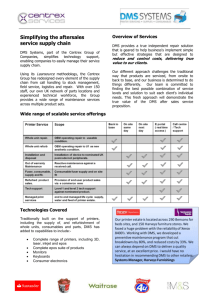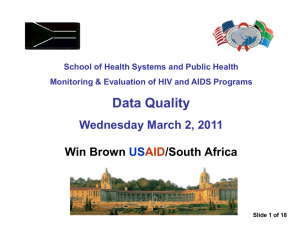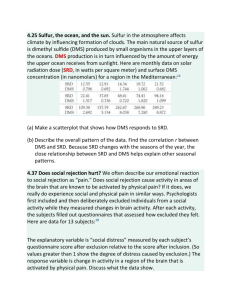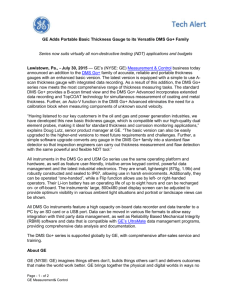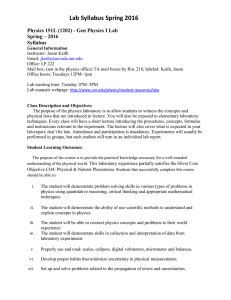T Defense Message System (DMS) DOD PROGRAMS
advertisement
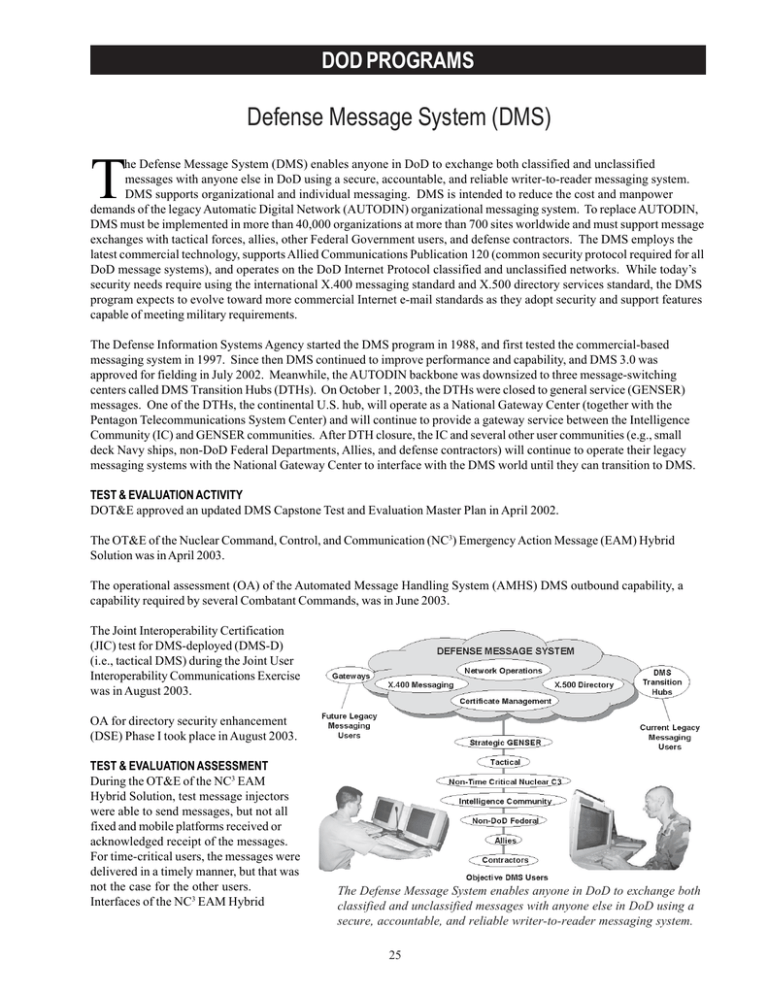
DOD PROGRAMS Defense Message System (DMS) T he Defense Message System (DMS) enables anyone in DoD to exchange both classified and unclassified messages with anyone else in DoD using a secure, accountable, and reliable writer-to-reader messaging system. DMS supports organizational and individual messaging. DMS is intended to reduce the cost and manpower demands of the legacy Automatic Digital Network (AUTODIN) organizational messaging system. To replace AUTODIN, DMS must be implemented in more than 40,000 organizations at more than 700 sites worldwide and must support message exchanges with tactical forces, allies, other Federal Government users, and defense contractors. The DMS employs the latest commercial technology, supports Allied Communications Publication 120 (common security protocol required for all DoD message systems), and operates on the DoD Internet Protocol classified and unclassified networks. While today’s security needs require using the international X.400 messaging standard and X.500 directory services standard, the DMS program expects to evolve toward more commercial Internet e-mail standards as they adopt security and support features capable of meeting military requirements. The Defense Information Systems Agency started the DMS program in 1988, and first tested the commercial-based messaging system in 1997. Since then DMS continued to improve performance and capability, and DMS 3.0 was approved for fielding in July 2002. Meanwhile, the AUTODIN backbone was downsized to three message-switching centers called DMS Transition Hubs (DTHs). On October 1, 2003, the DTHs were closed to general service (GENSER) messages. One of the DTHs, the continental U.S. hub, will operate as a National Gateway Center (together with the Pentagon Telecommunications System Center) and will continue to provide a gateway service between the Intelligence Community (IC) and GENSER communities. After DTH closure, the IC and several other user communities (e.g., small deck Navy ships, non-DoD Federal Departments, Allies, and defense contractors) will continue to operate their legacy messaging systems with the National Gateway Center to interface with the DMS world until they can transition to DMS. TEST & EVALUATION ACTIVITY DOT&E approved an updated DMS Capstone Test and Evaluation Master Plan in April 2002. The OT&E of the Nuclear Command, Control, and Communication (NC3) Emergency Action Message (EAM) Hybrid Solution was in April 2003. The operational assessment (OA) of the Automated Message Handling System (AMHS) DMS outbound capability, a capability required by several Combatant Commands, was in June 2003. The Joint Interoperability Certification (JIC) test for DMS-deployed (DMS-D) (i.e., tactical DMS) during the Joint User Interoperability Communications Exercise was in August 2003. OA for directory security enhancement (DSE) Phase I took place in August 2003. TEST & EVALUATION ASSESSMENT During the OT&E of the NC3 EAM Hybrid Solution, test message injectors were able to send messages, but not all fixed and mobile platforms received or acknowledged receipt of the messages. For time-critical users, the messages were delivered in a timely manner, but that was not the case for the other users. Interfaces of the NC3 EAM Hybrid The Defense Message System enables anyone in DoD to exchange both classified and unclassified messages with anyone else in DoD using a secure, accountable, and reliable writer-to-reader messaging system. 25 DOD PROGRAMS Solution experienced difficulties operating with some of the legacy systems. Even though the NC3 EAM Hybrid Solution does not employ Internet standards and is less vulnerable to attack, the security practices were weak and required improvement. The NC3 community corrected the deficiencies in August 2003 and Joint Staff J3 authorized a six-month period of concurrent operations with the DTH legacy distribution alternative as the backup system. The DTHs will remain open for NC3 traffic-only after September 30, 2003, until the successful completion of the six-month parallel operations. The AMHS DMS outbound capability worked well during the OA. DOT&E did not identify any major deficiencies. The AMHS approach reflects the general trend for DMS organizational messaging to be from automated message center-toautomated message center rather than from writer-to-reader. The Joint Interoperability Test Command (JITC) conducted the JIC test in August 2003 to obtain an interoperability certification for DMS-D to support an authority to operate as required by Chairman, Joint Chiefs of Staff Instruction 6212.01B (Interoperability and Supportability of National Security Systems and Information Technology Systems). This test was not a full OA or OT&E, but DOT&E followed it closely in order to clarify suspected operational suitability issues of DMS in the tactical environment. The test did not yield sufficient, repeatable results for the JITC to grant an interoperability certification. The operators complained that DMS was difficult to set up and maintain. The set-up process is significant to the tactical community because this process is necessary every time a force deploys and redeploys in contrast to the strategic community, which incurs this process essentially only once for its largely fixed-site infrastructure. As a result of the failure of DMS-D in the JIC test, a second JIC test has been proposed to coincide with the DoD Interoperability Communications Exercise in the February-March 2004 timeframe. DOT&E’s conclusion from the first JIC test is that the Services must train their operators more thoroughly and DMS procedures must be simplified in order to facilitate effective operations. Following the successful OA for the DSE Phase I, the Defense Information Systems Agency recommended the DSE Phase I for fielding in September 2003. The IC requires DSE Phase II before fielding DMS, but Phase II will not be ready until CY04. The Test and Evaluation Master Plan requires future testing of DMS for DSE Phase II and for various maintenance releases and version upgrades for both the IC and DoD tactical community. 26
